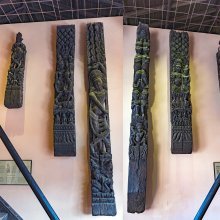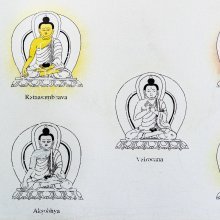Parishkrita, Pariṣkṛta, Parikṛta, Pariskrita, Parikrita, Pari-krita: 10 definitions
Introduction:
Parishkrita means something in Hinduism, Sanskrit, Marathi. If you want to know the exact meaning, history, etymology or English translation of this term then check out the descriptions on this page. Add your comment or reference to a book if you want to contribute to this summary article.
The Sanskrit terms Pariṣkṛta and Parikṛta can be transliterated into English as Pariskrta or Parishkrita or Parikrta or Parikrita, using the IAST transliteration scheme (?).
Images (photo gallery)
In Hinduism
Mantrashastra (the science of Mantras)
Source: OAPEN: Adaptive Reuse: Aspects of Creativity in South Asian Cultural HistoryPariṣkṛta (परिष्कृत) refers to “that which is prepared” (through presence and absence), according to Utpala Vaiṣṇava’s commentary (called Spandapradīpikā) on the Spandakārikā by Vasugupta.—Accordingly, “And moreover, [it is said] in the Saṅkarṣaṇasūtras: ‘The form of consciousness, which is installed in itself alone, and is prepared through presence and absence (bhāvābhāva-pariṣkṛta), is perceivable through self-awareness, and its sphere of knowledge lies beyond nature. This source of the mantras is recollected, o sage, to consist of cognition. These mantras, which appear externally and internally in the form of phonemes rest on the undivided level. Like the [sense] organs of the embodied beings, when they are employed, [the mantras] are successful at all times because of the connection with vigour”.
Mantrashastra (शिल्पशास्त्र, mantraśāstra) refers to the ancient Indian science of mantras—chants, incantations, spells, magical hymns, etc. Mantra Sastra literature includes many ancient books dealing with the methods reciting mantras, identifying and purifying its defects and the science behind uttering or chanting syllables.
Languages of India and abroad
Marathi-English dictionary
Source: DDSA: The Molesworth Marathi and English Dictionarypariṣkṛta (परिष्कृत).—a S Highly finished, elaborate, ornate--a composition &c.
Marathi is an Indo-European language having over 70 million native speakers people in (predominantly) Maharashtra India. Marathi, like many other Indo-Aryan languages, evolved from early forms of Prakrit, which itself is a subset of Sanskrit, one of the most ancient languages of the world.
Sanskrit dictionary
Source: DDSA: The practical Sanskrit-English dictionaryPariṣkṛta (परिष्कृत).—p. p.
1) Adorned, decorated; जज्ञे निवेशनविभागपरिष्कृतानां लक्ष्मीः पुरोपवनजा वनपादपानाम् (jajñe niveśanavibhāgapariṣkṛtānāṃ lakṣmīḥ puropavanajā vanapādapānām) Kirātārjunīya 7.4.
2) Cooked, dressed.
3) Purified by initiatory ceremonies; (see kṛ with pari).
4) Prepared, equipped.
5) Highly polished.
Source: Cologne Digital Sanskrit Dictionaries: Shabda-Sagara Sanskrit-English DictionaryPariṣkṛta (परिष्कृत).—mfn.
(-taḥ-tā-taṃ) 1. Adorned, decorated, embellished. 2. Highly finished or polished. 3. Cooked, dressed. 4. Purified by initatory rites. 5. Surrounded, encompassed. E. pari before, kṛ to make, aff. kta. see the last.
Pariṣkṛta can also be spelled as Pariskṛta (परिस्कृत).
Source: Cologne Digital Sanskrit Dictionaries: Cappeller Sanskrit-English DictionaryPariṣkṛta (परिष्कृत).—[adjective] prepared, arranged, adorned, accompanied by (—°).
Source: Cologne Digital Sanskrit Dictionaries: Monier-Williams Sanskrit-English Dictionary1) Parikṛta (परिकृत):—[=pari-kṛta] [from pari-kṛ] mfn. surrounded, [Mahābhārata]
2) Parikrīta (परिक्रीत):—[=pari-krīta] [from pari-krī] mfn. purchased, bought, hired, [Mahābhārata] (applied to a son = reto-mūlya-dānena tasyām eva [i.e. bhāryāyām] janitaḥ, [Nīlakaṇṭha])
Source: Cologne Digital Sanskrit Dictionaries: Monier-Williams Sanskrit-English Dictionary1) Pariṣkṛta (परिष्कृत):—[=pari-ṣ-kṛta] [from pariṣ-kṛ] mfn. (pari-) prepared, adorned, embellished, furnished with, surrounded or accompanied by ([instrumental case] or [compound]), [Ṛg-veda] etc. etc.
2) [v.s. ...] cooked, dressed, [Horace H. Wilson]
3) [v.s. ...] purified, initiated, [ib.]
Source: Cologne Digital Sanskrit Dictionaries: Yates Sanskrit-English DictionaryPariṣkṛta (परिष्कृत):—[pari-ṣkṛta] (taḥ-tā-taṃ) a. Adorned; highly finished, &c.
Sanskrit, also spelled संस्कृतम् (saṃskṛtam), is an ancient language of India commonly seen as the grandmother of the Indo-European language family (even English!). Closely allied with Prakrit and Pali, Sanskrit is more exhaustive in both grammar and terms and has the most extensive collection of literature in the world, greatly surpassing its sister-languages Greek and Latin.
Kannada-English dictionary
Source: Alar: Kannada-English corpusParikṛta (ಪರಿಕೃತ):—[adjective] covered completely; enveloped; encircled.
--- OR ---
Parikṛta (ಪರಿಕೃತ):—[noun] a man who is surrounded by several persons.
Source: Alar: Kannada-English corpusPariṣkṛta (ಪರಿಷ್ಕೃತ):—
1) [adjective] corrected; rectified; reformed.
2) [adjective] ornamented; beautified; embelished.
3) [adjective] surrounded; encircled.
4) [adjective] prepared; ready.
5) [adjective] smoothened; brightened; polished.
6) [adjective] purified; cleaned.
--- OR ---
Pariṣkṛta (ಪರಿಷ್ಕೃತ):—
1) [noun] a man who is ornamented and beautified.
2) [noun] a man who is improved or corrected, as in behavior or morals or made better by the removal of errors, abuses, etc.; a reformed man.
3) [noun] a sinless, virtuous man.
Kannada is a Dravidian language (as opposed to the Indo-European language family) mainly spoken in the southwestern region of India.
See also (Relevant definitions)
Partial matches: Krita, Paris, Pari.
Starts with: Parishkritabhumi, Parishkritamudrana.
Ends with: Aparishkrita, Jatarupaparishkrita, Suparishkrita.
Full-text: Aparishkrita, Parishkritabhumi, Jatarupaparishkrita, Suparishkrita, Parikri, Parikkhata, Prativastu, Vrinda, Bhavabhava, Kar.
Relevant text
Search found 4 books and stories containing Parishkrita, Pariṣkṛta, Pariṣ-kṛta, Parish-krita, Parikṛta, Pari-krīta, Pari-krta, Parikrta, Parikrīta, Pari-kṛta, Paris-krta, Pariskṛta, Pariskrta, Pariskrita, Parikrita, Pari-krita; (plurals include: Parishkritas, Pariṣkṛtas, kṛtas, kritas, Parikṛtas, krītas, krtas, Parikrtas, Parikrītas, Pariskṛtas, Pariskrtas, Pariskritas, Parikritas). You can also click to the full overview containing English textual excerpts. Below are direct links for the most relevant articles:
Rig Veda (translation and commentary) (by H. H. Wilson)
Chandogya Upanishad (english Translation) (by Swami Lokeswarananda)
Bhakti-rasamrta-sindhu (by Śrīla Rūpa Gosvāmī)
Verse 3.2.44 < [Part 2 - Affection and Service (dāsya-rasa)]
Formal Education System in Ancient India (by Sushmita Nath)
Subjects studied in the Saṃhitā Period < [Chapter 5 - Subjects studied in the Vedic and Buddhist period]
Education system in the Saṃhitā Period < [Chapter 1 - Introduction]

